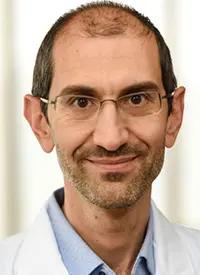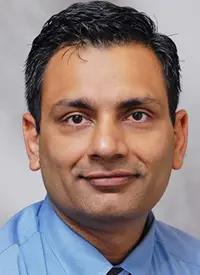Community/Academic Research Collaboration Paves the Way for Improved Cancer Care
Gautam Jha, MD, and Emmanuel Antonarakis, MD, discuss the ins and outs of clinical trial partnerships between community and academic cancer centers.
Emmanuel Antonarakis, MD

Investing time and effort in clinical trial partnerships between community and academic cancer centers begins with opening sustained lines of communication between community oncologists, academic oncologists, and their patients, thus creating long-term relationships that increase the scope of clinical research, according to Gautam Jha, MD. These partnerships strengthen the ultimate goal of providing high-quality, accessible care to all patients with cancer, Emmanuel Antonarakis, MD, added.
In an interview with OncLive®, Jha and Antonarakis discussed potential strategies for maximizing patient accrual to clinical trials; potential barriers when considering clinical trial partnerships between community and academic cancer centers; and the importance of keeping patient care at the forefront of all clinical research endeavors, regardless of where patients receive treatment. This conversation builds on Jha’s and Antonarakis’ commentary on the role community oncology centers played in patient accrual at the University of Minnesota during the phase 3 ECLIPSE trial (NCT05204927) of 177Lu-PSMA-I&T in patients with metastatic castration-resistant prostate cancer who had progressed on or after prior treatment with an androgen receptor–directed agent.
Gautam Jha, MD

Jha is the medical director for the M Health Fairview Masonic Cancer Clinic and the Advanced Treatment Center at the M Health Fairview Clinics and Surgery Center—Minneapolis in Minnesota. He is also the chair of the cancer committee for M Health Fairview Ridges Hospital.
Antonarakis is associate director of Translational Research at the Masonic Cancer Center, University of Minnesota, in Minneapolis and the Clark Endowed Professor of Medicine at the U of M Medical School.
OncLive: How could the clinical trial accrual process be streamlined to maximize the accrual of patients from community cancer centers?
Jha: It takes the first [clinical trial] to build these relationships [between community and academic centers] and then gradually, [community centers] start relying on [academic centers] for trials. If [community oncologists] have difficult-to-treat patients, they always reach out to [their academic colleagues]. The first time [requires] a lot more effort [in] reaching out to the [community] oncologists and trying to explain to them what [relevant trials] are available [at academic centers such as the] University of Minnesota system.
[In Minnesota], we have been trying as much as possible to open trials at both the university site and the community sites at the same time. That helps accrual quite a bit because most patients wouldn’t want to travel to the university. If you can conduct the trials in the community itself, [patients] are much happier. That helps accrual quite significantly.
Antonarakis: The experience of the ECLIPSE trial helped bridge some relationships [that may] be ongoing in the future. When university physicians such as myself collaborate closely with community physicians such as Dr Jha, everyone benefits, not just the patients. We benefit as physicians because we have 2 opinions on every patient.
[Additionally], everyone feels more like a community. Our research nurses on the university campus and the research nurses at the satellite clinics feel [like a] part of the same team. We conduct video teleconference visits once every 2 weeks to review data on the trial: the safety, toxicity, logistical concerns, and questions about adverse effects [AEs]. Dr Jha and myself, as well as both of our research teams, are present on those calls.
The [question] we are focusing on now for the future is: Are there other clinical trials in which we can use this model, whereby even the treatment itself can be administered at a satellite clinic? For example, we have an ongoing trial using a different therapeutic agent for patients with advanced prostate cancer, where patients identified in the community [can] receive the experimental investigational treatment in the community. Those patients never have to come down to the University of Minnesota's main campus, even once. The whole experience from beginning to end, [including] enrollment, participation, drug therapy, conclusion of the trial, and all the scans and blood work in between, can be done in the community.
The ECLIPSE trial was the first [trial in which] we [conducted a partnership between community centers and the University of Minnesota] so successfully, and it will not be the last. We are looking for more trials where the investigational agent may not be as complicated as the radioligand [studied in ECLIPSE]. In those trials, patients may be able to stay in the community for their entire clinical trial trajectory.
How feasible are clinical trial collaborations between academic and community oncology centers in the United States? What barriers may be preventing more of these partnerships from occurring?
Jha: [These partnerships are] absolutely feasible and beneficial. [They are] in everyone’s interest. One challenge community oncologists face is they are not aware of all the trials that are available for their patients. A university oncologist [may] see only [patients with] prostate cancer or maybe, at the most, genitourinary cancers, whereas community oncologists see [patients with diseases ranging from] prostate cancer to leukemia, lymphoma, and [beyond]. They have to be up to date with everything. That limits their ability to [fully] understand the clinical trial options and the latest recommendations. [Community oncologists may] keep up with the recommendations for [these diseases], but they’re not as motivated to seek out trials at every stage [of disease].
Secondly, [conducting trials in the community] is difficult because it takes more time. If [community oncologists] enroll their patients on a trial, they have to do the training for the trial or they might have to refer the patient [to another cancer center] if they do [not do] the training themselves. It is a [large] time commitment. There may be other requirements they might have to participate [in, such as] reporting serious AEs and radiographic measurements. A host of [requirements] come along with [clinical trial participation]. University oncologists have a lot of time built in for this, but community oncologists don’t have the same time.
[Furthermore], if [community oncologists] refer patients [to academic centers], they [may be] a little worried. What if the patients don’t come back to them? [Sometimes], the university oncologists would like to keep the patients, and sometimes the patients—if they liked the experience of being treated by [academic center] experts and liked the conversations they had—would like to stay at the university site and don’t want to go back [to their community site]. [Community oncologists have] this fear of losing patients. Multiple logistical hurdles have limited clinical trial enrollment [in the community] and limited such partnerships [between community and academic sites].
Antonarakis: Historically, there have been myths or misunderstandings about the relationship between academic oncologists and community oncologists. One thing I’ve learned in my short career so far is that there is an increasing mutual respect for the different skill sets we both have. Community oncologists should look at [academic oncologists] as people to refer [patients to] for clinical trials [and as] people to discuss challenging cases with. I am more than happy, for example, to talk on the telephone or answer an email about a challenging case, even if I know that patient is not eligible for a clinical trial or will not come to the university, just to provide advice. That relationship goes beyond the clinical trial. I do not want my community colleagues to think of me only when a patient might be eligible for a study; rather, [I want them to reach out for] a case where there’s a diagnostic dilemma or a treatment fork in the road where they have to make decision A vs decision B.
The second lesson I’ve learned is that it’s important to send the patients back to the referring physician if you do not have a trial they qualify for. We do not want to be getting the reputation that we are stealing patients from the community. That is not our intention. Our intention is to assess patients’ willingness and eligibility for a trial. It doesn’t always work out.
In the cases where it doesn’t work out, we have to be respectful. I’ve learned to send the patients back. Often the patients want this [since] they’re more familiar with their local physician. The physicians have relationships with those patients, and they don’t want to abandon them either. Based on some old and new ways of doing business, the relationship [between community and academic oncologists] has become a lot more collaborative from both directions. This helps dispel some myths about rivalries or frictions between the academic sector and the community sector.
What are your main messages for colleagues regarding the potential for future collaboration between community and academic oncologists?
Jha: These collaborations are beneficial for both [community and academic oncologists]. Academic oncologists should be [available] to provide advice in every situation, so their colleagues in the community will reach out to them with difficult-to-treat patients, unusual circumstances, or [to inquire about] a clinical trial. That line of communication should be open, and the response has to be timely. If you have those 2 things, you will have great responses and collaborations.
Community oncologists often need advice and expertise [from academic oncologists], which is often lacking [in the community setting] because the oncology field is becoming so specialized. Gone are the days when we had only 2 or 3 treatment options for prostate cancer. The treatment paradigm is changing every day. [Community oncologists] simply cannot keep up with that. [Increased communication] would help community oncologists and [allow] academic oncologists to provide feedback and [collect information about] patients for trial accrual.
Antonarakis: We as physicians and oncologists should keep doing what we’ve always done, which is keeping the patient at the center. If our primary concern is doing our best for the patient, in certain circumstances, that might be [actions taken] in the community; in other circumstances, that might be [actions taken at] academic centers. [Cancer care] shouldn’t be about whether the university or the private practice is going to benefit more. It should be about: How is my patient going to benefit the most? Oftentimes, you would be surprised that what benefits the patient the most may also benefit research at the same time.
Reference
177Lu-PSMA-I&T for metastatic castration-resistant prostate cancer. ClinicalTrials.gov. Updated February 29, 2024. Accessed March 4, 2024. https://clinicaltrials.gov/study/NCT05204927



